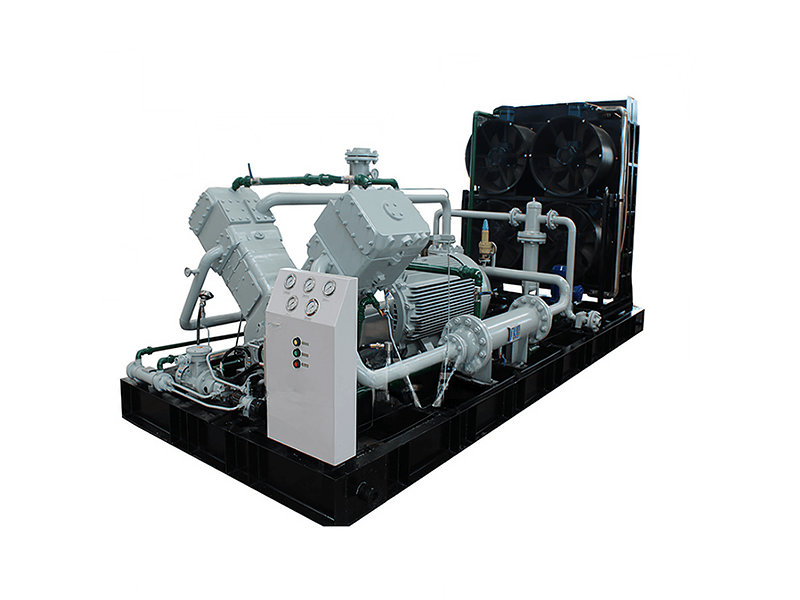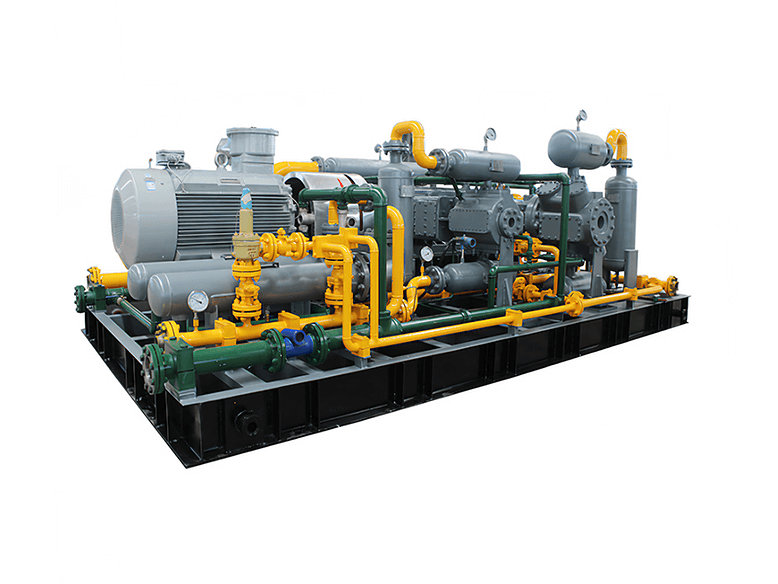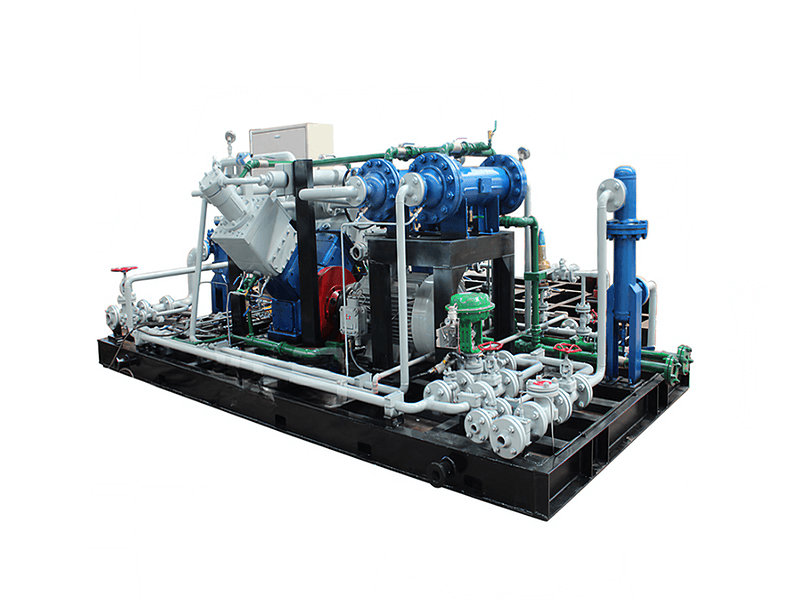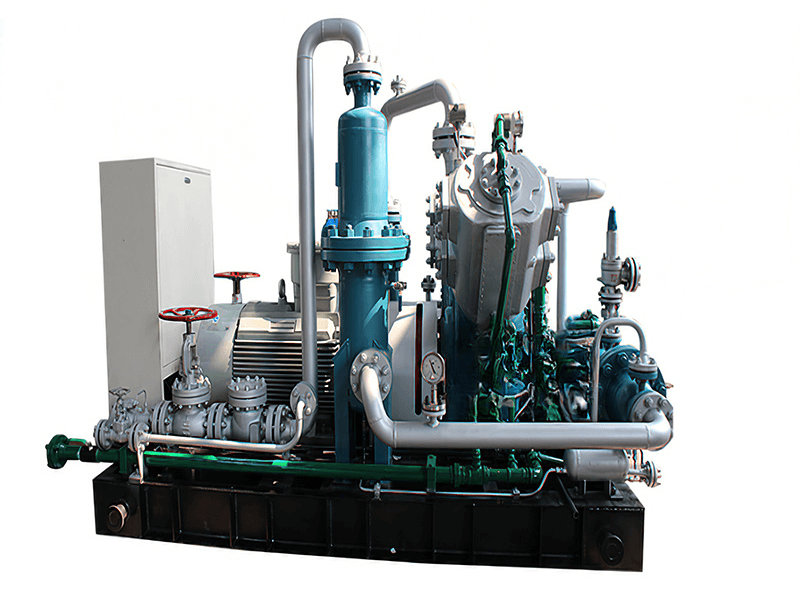In petrochemical production processes, the selection of process gas compressors is directly related to the safe, stable operation and economic benefits of the entire production plant. Special media such as cracked gas, reformed gas, and hydrotreating off-gas feature complex compositions, strong corrosiveness, and demanding operating conditions, necessitating targeted technical solutions and special designs. Petrochemical plants typically operate continuously for several years before major overhauls, making compressor reliability and long-cycle run capability particularly important. Furthermore, the energy consumption of process gas compressors accounts for a significant portion of the plant's total energy use; optimized selection affects not only the initial investment but also long-term operating costs. This requires the selection process to comprehensively consider technical feasibility, safety, reliability, economic rationality, and other factors to develop the optimal solution.
I. Characteristics and Challenges of Petrochemical Process Gases
Petrochemical process gases often contain corrosive components such as hydrogen, hydrogen sulfide, chloride ions, and cyanides, and frequently operate under high temperature and pressure conditions. Taking cracked gas as an example, its typical composition includes hydrogen (10%-15%), methane (15%-20%), ethylene (25%-30%), propylene (10%-15%) and other hydrocarbon compounds, along with small amounts of hydrogen sulfide (100-500 ppm) and organic sulfides (e.g., COS, CS₂). This complex composition places extremely high demands on compressor materials, requiring appropriate metal selection based on the corrosion characteristics of the medium.
Besides complex chemical composition, petrochemical process gases also feature wide temperature and pressure ranges, varying molecular weights, and complex phase behavior. For instance, in hydrotreating units, compressors need to handle gases at different pressure levels from atmospheric pressure to 20 MPa; in ethylene plants, the inlet pressure of a cracked gas compressor might be only 0.1 MPa, while the outlet pressure can reach 3.5-4.0 MPa, with a compression ratio exceeding 30. These characteristics require compressor design to fully account for changes in gas properties, especially thermodynamic behavior near critical points, to avoid abnormal conditions such as condensate slugging or surge.
II. Science and Engineering Practice in Material Selection
For media containing hydrogen sulfide, when the partial pressure exceeds 0.0003 MPa, sulfur-resistant corrosion materials must be used, and hardness controlled to not exceed HRC 22. Material selection should refer to NACE MR0175/ISO 15156 standards, typically selecting austenitic stainless steel 316L, duplex steel 2205, or nickel-based alloy 625. For conditions with high chloride ion content, the risk of stress corrosion cracking must also be considered, potentially necessitating the use of advanced materials like Hastelloy C-276. In practical engineering, material selection must balance not only corrosion resistance but also mechanical properties, manufacturability, and economics. For example, duplex steel 2205 offers excellent resistance to chloride stress corrosion cracking but requires strict control of heat input and interpass temperature during welding.
The application of material compatibility curves is crucial. These curves show the corrosion rates of different materials under various temperature, pressure, and medium concentration conditions, providing a scientific basis for selection. For instance, in high-temperature hydrogen environments, the Nelson curve must be referenced to select hydrogen attack resistant materials. The Nelson curve, based on extensive operational data, indicates the usage limits of different steels in hydrogen environments. When the operating temperature exceeds 200°C and the hydrogen partial pressure is above 0.7 MPa, carbon steel and low-alloy steels experience significant hydrogen attack, requiring the selection of molybdenum or chromium-molybdenum steels. For acidic media, the Couper-Gorman curve is used to determine suitable alloy materials, providing material selection guidance based on H₂S partial pressure and pH value.
During actual selection, the setting of corrosion allowances must also be considered. Corrosion allowances are calculated based on the expected equipment lifespan and corrosion rate, generally not less than 3 mm. Determining the corrosion rate requires referencing actual operational data from similar conditions or obtaining it through laboratory corrosion tests. For critical equipment, specialized corrosion tests simulating actual process conditions (temperature, pressure, flow velocity, medium composition, etc.) are recommended to obtain more accurate corrosion data. Additionally, localized corrosion phenomena such as pitting, crevice corrosion, and galvanic corrosion must be considered, as these are often more destructive than uniform corrosion.
III. Refined Design of Pre-treatment Systems
Integrated pre-treatment systems are key to ensuring long-term stable compressor operation. For process gases containing solid particles, a multi-stage filtration system is required, typically including a primary cyclone separator, intermediate bag filter, and final precision filter, controlling solid particle content below 5 mg/m³. Cyclone separators use centrifugal force to separate larger particles (typically >10 μm), requiring optimized inlet velocity and structure design for improved efficiency. Bag filters capture medium-sized particles (1-10 μm), with special attention paid to bag material selection for temperature resistance, corrosion resistance, and good dust release characteristics. Precision filters (e.g., sintered metal cartridges) remove fine particles (0.1-1 μm), serving as the final defense for long-term compressor operation.
For gases containing liquid droplets, high-efficiency gas-liquid separators are needed to ensure outlet gas liquid carryover is below 0.1 ml/m³. High-efficiency separators typically use baffles, mesh pads, or vane packs, requiring a balance between separation efficiency and pressure drop in the design. For fine mists, fiber coalescing filters can be used, capturing sub-micron droplets via mechanisms like Brownian diffusion, interception, and inertial impaction. Material selection for separators is equally important, requiring resistance to medium corrosion, while internal structure design should avoid liquid traps to prevent localized corrosion.
Temperature control is also crucial, requiring a pre-cooler to control the inlet temperature within a suitable range while avoiding condensation corrosion. Cooler design must fully consider process gas characteristics; for gases prone to fouling, easily cleanable structures (e.g., removable tube bundles) should be used; for corrosive gases, corrosion-resistant materials or coatings should be selected. The response speed of the temperature control system is critical, needing to adapt to operational changes and avoid excessive temperature fluctuations leading to condensation or overheating.
For certain special media, online monitoring systems need to be added to detect real-time gas composition changes and adjust operating parameters promptly. Online analyzers like gas chromatographs and mass spectrometers can continuously monitor gas composition, providing basis for operational adjustments. Parameters like pH and conductivity can also be monitored online for early anomaly detection. This monitoring data should be integrated into the control system for automatic adjustment and early warning.

IV. Application of Advanced Sealing Technology
Seal system selection requires special attention. For flammable, explosive, or toxic media, dry gas seal systems are typically used, coupled with a nitrogen buffer system, to ensure zero process gas leakage to the environment. Dry gas seals are non-contact mechanical seals that rely on a micrometer-thin gas film for sealing, featuring low friction, long life, and minimal leakage. The seal system design includes primary seals, secondary seals, and the buffer gas system, forming multiple protective barriers.
Seal gas pressure and flow require precise control, generally maintained at 0.2-0.3 MPa above the process gas pressure. Pressure control needs precision control valves and pressure sensors to ensure stability and reliability. The seal gas supply must be clean and dry, typically requiring dedicated filtration and drying units to prevent particles or droplets from entering the seal faces and causing damage. For large critical units, redundant configuration with a standby seal gas source is recommended, ensuring automatic switchover in case of primary source failure.
For certain special conditions, double seals or tandem seal systems may be necessary to provide an additional safety barrier. Double seal systems introduce a buffer gas between the two sets of seal faces; the buffer gas pressure is maintained between the process gas and atmospheric pressure, ensuring that medium does not directly leak to the environment if either the process-side or atmosphere-side seal fails. Tandem seal systems feature two sets of seals arranged in series, sharing the pressure differential, suitable for higher pressure applications. The choice of seal type should be based on risk assessment, considering medium hazard, operating pressure, and reliability requirements.
V. Optimal Design of Cooling Systems
Cooling system design also needs optimization based on process gas characteristics. For high-temperature gases, a staged cooling approach is typically used, controlling the temperature drop per stage within a reasonable range to avoid thermal stress. The temperature drop per stage is generally controlled between 50-80°C, depending on the material's coefficient of thermal expansion and structural design. The cooling process flow needs optimization,合理安排intercooler locations and quantities to balance cooling effectiveness with avoiding excessive pressure loss.
Cooler tube bundle materials must be compatible with the process gas, while also considering the effects of fouling and corrosion. Common tube materials include carbon steel, stainless steel, duplex steel, copper alloys, etc., selected based on a comprehensive consideration of thermal conductivity, corrosion resistance, and economics. Tube bundle arrangement is also important to ensure uniform gas distribution, avoiding localized high velocities that accelerate corrosion or low velocities leading to particle deposition. For media prone to fouling, online cleaning systems should be designed for periodic deposit removal to maintain heat transfer efficiency. Online cleaning can use mechanical (e.g., brushing) or chemical methods, requiring reserved cleaning interfaces and space in the design.
The design of the cooling water system should not be overlooked. For recirculating water systems, water quality indicators must be controlled to prevent scaling and biofouling. Water treatment chemicals can be used to inhibit corrosion and scaling, with periodic water quality monitoring. For air coolers, the impact of ambient temperature must be considered, designing for the most severe conditions and potentially incorporating spray cooling systems. In cold regions, freeze protection measures are necessary to prevent tube bundle freezing and rupture.
VI. Condition Monitoring and Intelligent Operation & Maintenance Systems
The configuration of vibration monitoring and fault diagnosis systems cannot be ignored. Implementing an online vibration monitoring system is recommended to monitor bearing vibration, shaft displacement, and other parameters in real-time, with multi-level alarms and trip settings. Vibration monitoring should include acceleration, velocity, and displacement parameters to comprehensively reflect unit condition. Advanced systems can perform spectrum analysis to identify typical fault characteristics like rotor unbalance, misalignment, and looseness. Phase analysis helps identify defects like rotor thermal bow or cracks.
Shaft displacement monitoring can detect thrust bearing wear or changes in gas thrust early, preventing rotor contact with stationary parts. Temperature monitoring points should cover bearings, seals, and the cooling system; temperature anomalies are often precursors to failure. For large units, rotor dynamic stress monitoring can be added to assess rotor fatigue life and predict remaining useful life.
Simultaneously, equip with an online lubricating oil analysis system to periodically check oil quality and predict equipment operating status. Online oil analysis can monitor indicators like viscosity, water content, acid number, and particulate contamination, reflecting lubricant condition in real-time. Wear debris analysis can detect early wear failures; analyzing particle morphology, composition, and quantity helps identify the wear location and severity. These systems can be integrated with the plant's DCS or SIS systems to enable intelligent operation and maintenance.
Big data-based intelligent diagnostic systems represent the future direction. By collecting historical operational data, establishing normal operation baselines, and using machine learning algorithms to identify abnormal patterns, early fault warning can be achieved. Digital twin technology can create a virtual model of the compressor, simulating actual operation, predicting performance changes, and optimizing maintenance strategies. These intelligent systems can significantly improve equipment reliability, reduce unplanned downtime, and lower maintenance costs.
VII. Maintenance-Friendly Design Philosophy
The overall machine design must also consider maintenance accessibility. Locations requiring frequent replacement of wear parts should feature quick-disassembly structures; key monitoring points should have sufficient inspection space and interfaces; for large units, field repair feasibility must be considered, potentially designing horizontally split casings.
Rotor assembly design should facilitate dynamic balance checking and adjustment, providing standard balancing planes. Bearings and seal components are best designed as modular units for overall removal and installation, reducing field repair time. Casing openings and flange design must充分考虑disassembly space, avoiding maintenance difficulties due to insufficient space. For large centrifugal compressors, a horizontally split casing structure can be used, facilitating field inspection of the rotor without needing to disconnect piping.
Auxiliary system layout should also consider maintenance needs. The lube oil console, seal gas system, etc., should be centrally located with adequate working space. Instruments and valves should be installed in easily accessible locations; critical instruments should have both local indication and remote transmission capabilities. Lifting device design must meet the requirements for the heaviest components, reserving sufficient headroom.
Furthermore, comprehensive maintenance documentation and training should be provided, including maintenance manuals, spare parts lists, special tools lists, and training plans. Utilizing Augmented Reality (AR) technology can provide intuitive maintenance guidance, improving efficiency and quality. Establishing a sound spare parts management system ensures the availability of critical spares, shortening maintenance downtime.
VIII. Comprehensive Techno-Economic Evaluation Methodology
When finalizing the compressor selection, a comprehensive techno-economic evaluation is necessary. This involves considering not only the initial investment cost but also the total life cycle cost, including energy consumption, maintenance, spare parts, and downtime losses. Methods like Net Present Value (NPV) or Internal Rate of Return (IRR) can be used for economic analysis, quantifying the economic benefits of different options.
Energy consumption analysis is particularly important, as compressors are often major energy consumers in a plant. Energy consumption under different operating conditions can be simulated and calculated, evaluating efficiency characteristics at part load. For variable load applications, energy-saving measures like Variable Frequency Drives (VFD) or adjustable inlet guide vanes can be considered. Waste heat recovery is also an effective way to reduce energy consumption, such as using compression heat to generate steam or heat process streams.
Reliability assessment should be based on historical data and failure mode analysis, predicting Mean Time Between Failures (MTBF) and Mean Time To Repair (MTTR). For critical equipment, redundant configuration or spare capacity can be used to improve plant availability. Risk analysis should identify potential failure modes and their consequences, implementing corresponding prevention and mitigation measures.
Finally, the overall machine design must also consider maintenance accessibility. Locations requiring frequent replacement of wear parts should feature quick-disassembly structures; key monitoring points should have sufficient inspection space and interfaces; for large units, field repair feasibility must be considered, potentially designing horizontally split casings.
Through the systematic solutions outlined above, the compression needs for various special process gases in the petrochemical industry can be effectively addressed, ensuring safe, stable, and efficient equipment operation, providing reliable guarantee for the long-cycle operation of the entire production plant. During the actual selection process, in-depth communication with specialized compressor manufacturers is recommended, providing detailed process parameters and medium composition to jointly develop the optimal technical solution. Attention should also be paid to technological developments, such as magnetic bearings, supercritical CO₂ cycles, and other innovative technologies that may bring new solutions for petrochemical compression applications.

























